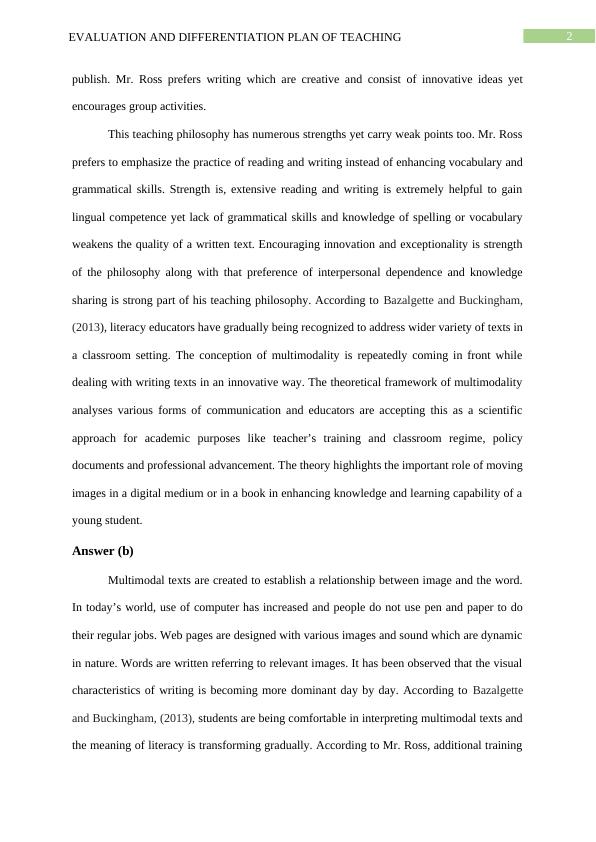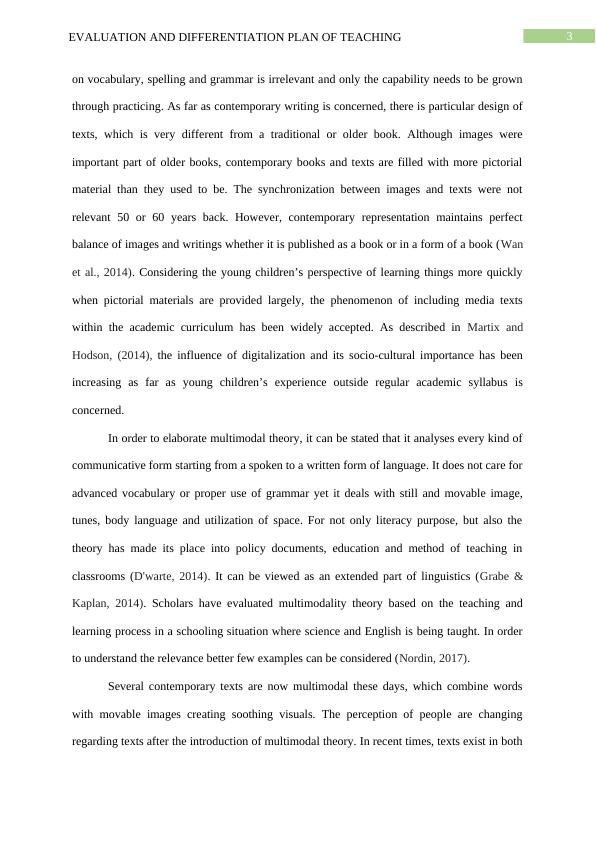Evaluation and Differentiation Plan of Teaching
Analyzing and evaluating the teaching philosophy and learning sequence for Year 5 students in writing and reading.
18 Pages5547 Words238 Views
Added on 2023-06-04
About This Document
This article discusses the evaluation and differentiation plan of teaching, including teaching philosophy, multimodal theory, and strategies for students who struggle with writing. It analyzes the strengths and weaknesses of Mr. Ross's teaching philosophy, the relevance of multimodal theory in contemporary writing, and strategies for students who struggle with writing due to learning disabilities or lack of experience.
Evaluation and Differentiation Plan of Teaching
Analyzing and evaluating the teaching philosophy and learning sequence for Year 5 students in writing and reading.
Added on 2023-06-04
ShareRelated Documents
Evaluation and Differentiation Plan of Teaching
Name of the university
Name of the student
Author note
Name of the university
Name of the student
Author note

1EVALUATION AND DIFFERENTIATION PLAN OF TEACHING
Teaching
philosophy/ teaching and
learning sequence selected
Indicate:
Innovation and creativity
Year level - 6
Teacher - Mr. Ross
Genre focus -
Explanation
Mr. Ross believes that students learn to write by reading and
read by writing. Individual knowledge and experience plays a
crucial role while producing contents of good quality. He has
considered the ability of innovation while creating texts and it
must be proofread extensively to ensure the quality. However,
he feels it is unnecessary to provide additional training for
grammar, spelling and vocabulary. It will eventually grow
with the advanced practice of reading and writing.
PART A - Evaluating the Teaching Philosophy and Learning Sequence
Answer (a)
As per Mr Ross’s teaching philosophy, learning is a process, which is not possible
without interdependence and interactive sessions among students. Integration of different
cultural and language competence is necessary to understand various lingual perspectives and
it will assist to increase their capability of reading and writing as well. According to him,
learning the language is important and for that vocabulary, grammar and spelling will not
need extra attention. As per De La Paz et al., (2014), it will grow eventually with the practice
of reading and writing. In order to produce realistic texts he prefers to provide readings in
classrooms like newspapers, books, magazines and e-books or relevant internet sources. Mr
Ross considers it as a knowledge enriched environment where a student can explore his or
her capabilities. Creating texts is a long process following levels of framing a draft,
redrafting, editing and proofreading. After executing all these steps, the texts get ready to
Teaching
philosophy/ teaching and
learning sequence selected
Indicate:
Innovation and creativity
Year level - 6
Teacher - Mr. Ross
Genre focus -
Explanation
Mr. Ross believes that students learn to write by reading and
read by writing. Individual knowledge and experience plays a
crucial role while producing contents of good quality. He has
considered the ability of innovation while creating texts and it
must be proofread extensively to ensure the quality. However,
he feels it is unnecessary to provide additional training for
grammar, spelling and vocabulary. It will eventually grow
with the advanced practice of reading and writing.
PART A - Evaluating the Teaching Philosophy and Learning Sequence
Answer (a)
As per Mr Ross’s teaching philosophy, learning is a process, which is not possible
without interdependence and interactive sessions among students. Integration of different
cultural and language competence is necessary to understand various lingual perspectives and
it will assist to increase their capability of reading and writing as well. According to him,
learning the language is important and for that vocabulary, grammar and spelling will not
need extra attention. As per De La Paz et al., (2014), it will grow eventually with the practice
of reading and writing. In order to produce realistic texts he prefers to provide readings in
classrooms like newspapers, books, magazines and e-books or relevant internet sources. Mr
Ross considers it as a knowledge enriched environment where a student can explore his or
her capabilities. Creating texts is a long process following levels of framing a draft,
redrafting, editing and proofreading. After executing all these steps, the texts get ready to

2EVALUATION AND DIFFERENTIATION PLAN OF TEACHING
publish. Mr. Ross prefers writing which are creative and consist of innovative ideas yet
encourages group activities.
This teaching philosophy has numerous strengths yet carry weak points too. Mr. Ross
prefers to emphasize the practice of reading and writing instead of enhancing vocabulary and
grammatical skills. Strength is, extensive reading and writing is extremely helpful to gain
lingual competence yet lack of grammatical skills and knowledge of spelling or vocabulary
weakens the quality of a written text. Encouraging innovation and exceptionality is strength
of the philosophy along with that preference of interpersonal dependence and knowledge
sharing is strong part of his teaching philosophy. According to Bazalgette and Buckingham,
(2013), literacy educators have gradually being recognized to address wider variety of texts in
a classroom setting. The conception of multimodality is repeatedly coming in front while
dealing with writing texts in an innovative way. The theoretical framework of multimodality
analyses various forms of communication and educators are accepting this as a scientific
approach for academic purposes like teacher’s training and classroom regime, policy
documents and professional advancement. The theory highlights the important role of moving
images in a digital medium or in a book in enhancing knowledge and learning capability of a
young student.
Answer (b)
Multimodal texts are created to establish a relationship between image and the word.
In today’s world, use of computer has increased and people do not use pen and paper to do
their regular jobs. Web pages are designed with various images and sound which are dynamic
in nature. Words are written referring to relevant images. It has been observed that the visual
characteristics of writing is becoming more dominant day by day. According to Bazalgette
and Buckingham, (2013), students are being comfortable in interpreting multimodal texts and
the meaning of literacy is transforming gradually. According to Mr. Ross, additional training
publish. Mr. Ross prefers writing which are creative and consist of innovative ideas yet
encourages group activities.
This teaching philosophy has numerous strengths yet carry weak points too. Mr. Ross
prefers to emphasize the practice of reading and writing instead of enhancing vocabulary and
grammatical skills. Strength is, extensive reading and writing is extremely helpful to gain
lingual competence yet lack of grammatical skills and knowledge of spelling or vocabulary
weakens the quality of a written text. Encouraging innovation and exceptionality is strength
of the philosophy along with that preference of interpersonal dependence and knowledge
sharing is strong part of his teaching philosophy. According to Bazalgette and Buckingham,
(2013), literacy educators have gradually being recognized to address wider variety of texts in
a classroom setting. The conception of multimodality is repeatedly coming in front while
dealing with writing texts in an innovative way. The theoretical framework of multimodality
analyses various forms of communication and educators are accepting this as a scientific
approach for academic purposes like teacher’s training and classroom regime, policy
documents and professional advancement. The theory highlights the important role of moving
images in a digital medium or in a book in enhancing knowledge and learning capability of a
young student.
Answer (b)
Multimodal texts are created to establish a relationship between image and the word.
In today’s world, use of computer has increased and people do not use pen and paper to do
their regular jobs. Web pages are designed with various images and sound which are dynamic
in nature. Words are written referring to relevant images. It has been observed that the visual
characteristics of writing is becoming more dominant day by day. According to Bazalgette
and Buckingham, (2013), students are being comfortable in interpreting multimodal texts and
the meaning of literacy is transforming gradually. According to Mr. Ross, additional training

3EVALUATION AND DIFFERENTIATION PLAN OF TEACHING
on vocabulary, spelling and grammar is irrelevant and only the capability needs to be grown
through practicing. As far as contemporary writing is concerned, there is particular design of
texts, which is very different from a traditional or older book. Although images were
important part of older books, contemporary books and texts are filled with more pictorial
material than they used to be. The synchronization between images and texts were not
relevant 50 or 60 years back. However, contemporary representation maintains perfect
balance of images and writings whether it is published as a book or in a form of a book (Wan
et al., 2014). Considering the young children’s perspective of learning things more quickly
when pictorial materials are provided largely, the phenomenon of including media texts
within the academic curriculum has been widely accepted. As described in Martix and
Hodson, (2014), the influence of digitalization and its socio-cultural importance has been
increasing as far as young children’s experience outside regular academic syllabus is
concerned.
In order to elaborate multimodal theory, it can be stated that it analyses every kind of
communicative form starting from a spoken to a written form of language. It does not care for
advanced vocabulary or proper use of grammar yet it deals with still and movable image,
tunes, body language and utilization of space. For not only literacy purpose, but also the
theory has made its place into policy documents, education and method of teaching in
classrooms (D'warte, 2014). It can be viewed as an extended part of linguistics (Grabe &
Kaplan, 2014). Scholars have evaluated multimodality theory based on the teaching and
learning process in a schooling situation where science and English is being taught. In order
to understand the relevance better few examples can be considered (Nordin, 2017).
Several contemporary texts are now multimodal these days, which combine words
with movable images creating soothing visuals. The perception of people are changing
regarding texts after the introduction of multimodal theory. In recent times, texts exist in both
on vocabulary, spelling and grammar is irrelevant and only the capability needs to be grown
through practicing. As far as contemporary writing is concerned, there is particular design of
texts, which is very different from a traditional or older book. Although images were
important part of older books, contemporary books and texts are filled with more pictorial
material than they used to be. The synchronization between images and texts were not
relevant 50 or 60 years back. However, contemporary representation maintains perfect
balance of images and writings whether it is published as a book or in a form of a book (Wan
et al., 2014). Considering the young children’s perspective of learning things more quickly
when pictorial materials are provided largely, the phenomenon of including media texts
within the academic curriculum has been widely accepted. As described in Martix and
Hodson, (2014), the influence of digitalization and its socio-cultural importance has been
increasing as far as young children’s experience outside regular academic syllabus is
concerned.
In order to elaborate multimodal theory, it can be stated that it analyses every kind of
communicative form starting from a spoken to a written form of language. It does not care for
advanced vocabulary or proper use of grammar yet it deals with still and movable image,
tunes, body language and utilization of space. For not only literacy purpose, but also the
theory has made its place into policy documents, education and method of teaching in
classrooms (D'warte, 2014). It can be viewed as an extended part of linguistics (Grabe &
Kaplan, 2014). Scholars have evaluated multimodality theory based on the teaching and
learning process in a schooling situation where science and English is being taught. In order
to understand the relevance better few examples can be considered (Nordin, 2017).
Several contemporary texts are now multimodal these days, which combine words
with movable images creating soothing visuals. The perception of people are changing
regarding texts after the introduction of multimodal theory. In recent times, texts exist in both

End of preview
Want to access all the pages? Upload your documents or become a member.
Related Documents
Evaluation and Differentiation Planlg...
|12
|2856
|55
